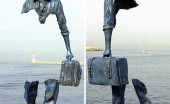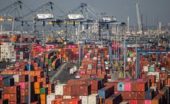Johannah Bernstein post: "eternally proud of my father’s extraordinary aeronautical engineering. legacy. here is a photo of the Canadair Water…
China and Japan 2012 – Senkaku/Diaoyu Islands
Written by Diana Thebaud Nicholson // September 20, 2012 // China, Japan // 1 Comment
See also: South China Sea
Senkaku/Diaoyu: Islands of Conflict
The historical roots of the dispute between China and Japan over control of the Senkaku/Diaoyu Islands reveal a great deal about the two countries’ current global standing, says Joyman Lee. (2011)
The dispute between China and Japan cannot be understood without grasping the complexities of nation state formation in Asia in the late 19th century. Despite the economic rise of East Asia since the Second World War border disputes remain an enduring legacy of the late 19th century when sharp differences of power existed between countries that understood the ways of the West, such as Russia and Japan, and those, such as China, which were less swift to respond. The fact that Japan had temporarily triumphed over the islands did not necessarily mean that an alternative worldview based on a different vision of legitimacy was completely wiped out. Tensions have subsided, probably briefly, in the aftermath of the earthquake and tsunami that devastated parts of Japan’s north-east coast in March. Yet Japan has ongoing border disputes not only with China but also with Russia and Korea. While these were marginal issues during the peak of its postwar economic expansion, since the 1990s gradual shifts in the balance of power in the region have highlighted Japan’s vulnerabilities in acute ways. As the discrepancy between the territorial status quo and the political and economic balance of power becomes more glaring in East Asia, the potential for conflict will only increase.

Could Asia really go to war over these?
The bickering over islands is a serious threat to the region’s peace and prosperity
(The Economist) Asia does indeed have reasons to keep relations good, and this latest squabble will probably die down, just as others have in the past. But each time an island row flares up, attitudes harden and trust erodes. Two years ago, when Japan arrested the skipper of a Chinese fishing boat for ramming a vessel just off the islands, it detected retaliation when China blocked the sale of rare earths essential to Japanese industry.
Growing nationalism in Asia, especially China, aggravates the threat (see article). Whatever the legality of Japan’s claim to the islands, its roots lie in brutal empire-building. The media of all countries play on prejudice that has often been inculcated in schools. Having helped create nationalism and exploited it when it suited them, China’s leaders now face vitriolic criticism if they do not fight their country’s corner. A recent poll suggested that just over half of China’s citizens thought the next few years would see a “military dispute” with Japan.
The islands matter, therefore, less because of fishing, oil or gas than as counters in the high-stakes game for Asia’s future.
19 September
China-Japan Dispute Over Islands Risks $340 Billion Trade
(Bloomberg) China and Japan’s worst diplomatic crisis since 2005 is putting at risk a trade relationship that’s tripled in the past decade to more than $340 billion.
Toyota Motor Corp. (7203), Honda Motor Co. (7267) and Panasonic Corp. (6752) reported damage to their operations in China as thousands marched in more than a dozen cities on Sept. 16 after Japan last week said it will purchase islands claimed by both countries. Protesters called for boycotts of Japanese goods and in some instances smashed store fronts and cars.
(Financial Times) Anti-Japan protests are spreading across China, causing Japanese retailers and manufacturers to shut operations, as tensions remain high between the Asian powers
The Inconvenient Truth Behind the Diaoyu/Senkaku Islands
By Han-Yi Shaw
The most interesting evidence is emerging from old Japanese government documents and suggests that Japan in effect stole the islands from China in 1895 as booty of war. This article by Han-Yi Shaw, a scholar from Taiwan, explores those documents. I invite any Japanese scholars to make the contrary legal case. – Nicholas Kristof
17 September
Disputed Islands
Tokyo Governor Shintaro Ishihara triggered the dispute in April when he said he may use public funds to buy the islands, known as Diaoyu in Chinese and Senkaku in Japanese, from a private Japanese owner. Tensions escalated after Japan’s cabinet approved the purchase of the islands for 2.05 billion yen ($26 million) on Sept. 11. China has said it doesn’t accept the move.
Anti-Japan protests — Outrage, to a point
(The Economist) ABOUT three thousand protesters gathered outside Shanghai’s Japanese consulate on September 16th. The young crowd, mostly aged 20-35, had draped themselves with the Chinese flag, chanting anti-Japan slogans and brandishing portraits of Chairman Mao. But the presence of riot police and soldiers had a sobering effect. Even as the protesters shouted for Japanese nationals to “get the hell out of China”, they waited obediently before filing towards the gates of the consulate in batches. Each group had an allotted ten-minute remonstrance at Japan’s official doorstep. They took their banners with them when they made their orderly series of exits.
Elsewhere things have been less peaceable. Over the weekend anti-Japan-themed protests erupted in dozens of Chinese cities, in what one observer has called the largest such widespread display since Japan established diplomatic relations with the People’s Republic in 1972. In Shenzhen, which borders Hong Kong, police used tear gas to control crowds. In Guangzhou 10,000 protestors took to the streets, according to the Japanese press. A Panasonic factory and a Toyota car dealership were both set on fire in the port city of Qingdao, as were Japanese-made cars in Xi’an. The embassy in Beijing got off lightly by that measure, being pelted with eggs and rocks.
Anti-Japanese tension, never far below the surface of public life in China, has bubbled to a boil over the past few weeks. On September 11th the Japanese government outraged China by buying the three Senkaku islands from a private owner, the only three it did not already possess. The islands as a group are known as the Diaoyus in China, which claims them as its own. On September 14th, Japan’s coast guard reported that six Chinese patrol ships entered Japanese territorial waters, in an apparent provocation. They left a few hours later.
15 September
Sino-Japanese maritime disputes — Islands apart
There is more than meets the eye to the countries’ tense stand-off
THE row between Japan and China over five islets that lie between them resurfaced again on September 11th when the Japanese government agreed to pay ¥2 billion ($26m) to buy, from their private owner, the three it does not already own. China reacted with outrage, and sent two patrol vessels to waters near what the Japanese call the Senkaku islands, and the Chinese call the Diaoyu.
Japan hopes this is more sound than fury. Yoshihiko Noda, the prime minister, may have bought the islands not to stir up troubled waters, but because he felt it was better than putting them into the hands of Shintaro Ishihara, governor of Tokyo and a crusty, China-baiting nationalist. In April Mr Ishihara launched a campaign for the Tokyo metropolitan government to buy them.
China may not see it Mr Noda’s way. Part of the problem is that, while much of the region resents what it sees as Chinese maritime expansion, China is troubled by Japan’s own maritime scope. Although the two nations have, by some estimates, roughly the same amount of coastline, Japan, an archipelago, claims an exclusive economic zone (EEZ) of 4.5m square km (2.8m square miles), five times more than China.
A recent paper by Gavan McCormack of the Australian National University argues that since the UN Convention on the Law of the Sea was ratified in 1982, Japan, thanks partly to a colonial legacy, has done better out of it than China. In EEZ terms, the latter ranks somewhere between the Maldives and Somalia as a maritime power.
11 September
Q&A: China-Japan islands row
(BBC) Ties between China and Japan have been repeatedly strained by a territorial row over a group of islands, known as the Senkaku islands in Japan and the Diaoyu islands in China. The BBC looks at the background to the row.
What is the row about?
The eight uninhabited islands and rocks in question lie in the East China Sea. They have a total area of about 7 sq km and lie northeast of Taiwan, east of the Chinese mainland and southwest of Japan’s southern-most prefecture, Okinawa.
They matter because they are close to strategically important shipping lanes, offer rich fishing grounds and are thought to contain oil deposits. The islands are controlled by Japan.
25 August
Make law, not war — How to solve spats over sea borders
LIKE toddlers scrapping over rubber ducks in a bathtub, countries are again quarrelling about the control of islets in the seas between them. The latest spat has blown up between Japan and China over an uninhabited archipelago. If ownership were to change, it would create a new sea border between the countries.
Maritime disputes are unlikely to go away soon. More than half the world’s sea borders—imaginary lines where countries meet—remain undrawn. Luckily, not all disputes end up triggering nationalist emotions or worse. Rather, a slow-motion scramble to fill in the gaps pushes on, with highly paid lawyers debating old maps, analysing treaties and thrashing out deals.
24 August
Much at stake for US as tensions rise in troubled China Seas
(NBC) Vast oil reserves, trillion-dollar trade routes, fervent nationalist sentiments, competing territorial claims and bitter histories – the waters off the east coast of China are a sea of money and a sea of trouble.
Tensions have been rising for several years and recently hit new heights with activists landing on disputed islands, angry diplomatic exchanges and even a threat to deploy troops, prompting fears of an armed conflict that could potentially involve the United States, China, Japan and other nations.
The South China Sea has a myriad of competing claims of ownership: China staked out most of it in 1947 but its neighbors have never accepted it. The Spratly Islands alone are claimed by a total of five countries: China, Taiwan, Malaysia, Philippines and Vietnam.
All are eyeing oil and gas reserves thought to be so rich that the area has become dubbed “The Second Persian Gulf.” Also, an estimated $5 trillion worth of trade is shipped through its waters.
20 August
The Sino-Japanese Naval War of 2012
OK, it’s probably not going to happen. But if it did, who would win?
(FP) Such a fight appeared farfetched before 2010, when Japan’s Coast Guard apprehended Chinese fishermen who rammed one of its vessels off the disputed islands, but it appears more likely now. After Japan detained and deported Chinese activists who landed on the disputed islands in mid-August, a hawkish Chinese major general, Luo Yuan, called on China to dispatch 100 boats to defend the Diaoyus. In an op-ed published Aug. 20, the nationalistic Chinese broadsheet Global Times warned, “Japan will pay a price for its actions … and the result will be far worse than they anticipated.”
This is more than mere posturing. In July, China’s East Sea Fleet conducted an exercise simulating an amphibious assault on the islands. China’s leaders are clearly thinking about the unthinkable. And with protesters taking to the streets to smash Japanese cars and attack sushi restaurants, their people may be behind them. So who would win the unlikely prospect of a clash of titans in the Pacific: China or Japan?




One Comment on "China and Japan 2012 – Senkaku/Diaoyu Islands"
I am actually more worried at the moment about China and Japan [than the Middle East]. I have no contacts in either country, but am swamped by more or less reliable opinions and info from Taipei [which has] very intelligent agents in both places, but the info is coloured, of course.